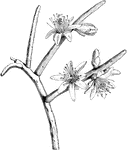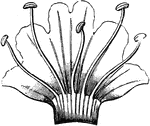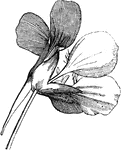Clipart tagged: ‘petals’

Abutilon
"Abutilon macropodum. 1. an unexpanded flower; 2. the stamens and styles; 3. a ripe fruit, consisting…

Ranunculus Aconitifolius
A plant which produces numerous flowers with oblong white petals. The leaves and stems are slightly…

Athamantha
"Athamanta cervariaefolia. 1. a separate flower, with hairy petals; 2. a petal by itself; 3. a ripe…

Large-Lipped Balsam
"Impatiens macrochila; 2. a diagram of its flower; 3. its stamens; 4. fruit of I. Balsamina (rose balsam);…

British Golden-rod
British Golden-rod is a member of the large composite genus Solidago, which is chiefly North American.…

Buttercup Flowers
"Flower of a buttercup (Ranunculus sp.); a, b, normal, showing 5 petals; c, d, petalody of stamens;…

Buttercup Flowers
"Rue anemone (Anemonella thalictroides). 1, normal flower with 5 petals; 3, petalody of stamens; 4,…

Funnelform Corolla
"In botany, applied to a monopetalous corolla shaped like a funnel, in which the tube enlarges gradually…

Liliaceous Corolla
"When the petals stand side by side with the claw, gradually expanding into a limb."—Darby, 1855

English Dogwood
The English Dogwood (Philadelphus coronarius) is a deciduous shrub, here showing its epigynous stamens…

Flowering Rush
The flower of the Flowering Rush (Butomus umbellatus), the sole species in the Butomaceae family.

Plectranthus Fruticocus
A flower with elegant blue petals. The pedals are approximately 1.5 inches in length.

Rhipsalis Funalis
A plant which produces flowers with 7 to 8 white petals. The stamens are very numerous. They bloom between…

Gentian
A genus of hardy plants, Gentians belong to the order Gentianaceae. They have a bitter taste, and one…

Common Grapevine
"Vitis vinifera. 1. a flower; 2. the same casting its petals; 3. the pistil and stamens; 4. a section…

Flower of Laelia Albida
The sepals are the three narrower parts situated behind, and overlapped by, the petals. The dark, central…

Lardizabala
"Lardizabala triternata. 1. petals and stamens of male flower; 2. carpels; 3. fruit of a Lardizabala;…

Dwarf Larkspur
The Delphinium tricorne or Dwarf Larkspur: "1. petals and stamens; 2. carpels; 3. a branch of ripe fruit."…

Rosa Centifolia Pomponia
A dwarf form of the Rosa centifolia, having small flowers and leaves. The flowers are rose-purple with…

Wild Rose
"Wild rose. A 'single' flower showing incipient doubling by the replacement of stamens by petals. Below,…

Sauvagesia
"Lavradia Vellozii. 1. an expanded flower; 2. the stamens with exterior petaloid scales; 3. a seed;…

Spiderwort Inflorescence
Tradescantia virginica. "It is a native of the central and southern United States, and was early introduced…

Turtleweed
"Batis maritima. 1. a male cone; 2. a male flower; 3. the same forced open to show the petals; 4. on…

Viper's Bugloss Corolla and Stamens
Echium vulgare (Viper's Bugloss) is a species of Echium native to most of Europe, and western and central…

Viviania
"Viviania crenata; 1. a flower; 2. a section of the ovary; 3. stamens and ovary." -Lindley, 1853

White Star
"Eriostemon myoporoides. 1. a complete flower; 2. the ovary, seated in a cup-shaped disk, surrounded…








